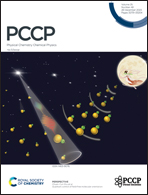Fourier-transform microwave spectroscopy of the s-trans-3-propenalyl (CH2CHĊO) and 3-propenolyl (ĊH2CHCO) radicals†
Abstract
Pure rotational transitions of two conformers of the CH2CHCO radical have been observed by Fourier-transform microwave spectroscopy, where one conformer is called the s-trans-3-propenalyl radical and the other the 3-propenolyl radical. The observed two conformers have different electronic states. The former, the s-trans-3-propenalyl radical, has the 2A′ electronic state and can be written as CH2CHĊO, where the unpaired electron resides mainly on the terminal CO carbon. On the other hand, the latter, 3-propenolyl radical has the 2A′′ electronic state and can be written as ĊH2CHCO. We were able to observe pure rotational transitions of the two conformers. Since both of the species have an unpaired electron, there exist spin–rotation interactions due to the unpaired electron and the magnetic hyperfine interactions due to the three coupling protons. The observed very complicated spectra, caused by these interactions, were assigned, leading to detailed molecular constants including the fine and hyperfine coupling constants for both of the species. The determined molecular constants support the electronic structures of the two conformers. There exists a controversy as to which of the two conformers is the lowest energy one. Our present observation led to the conclusion that s-trans-3-propenalyl is the lowest energy conformer.



 Please wait while we load your content...
Please wait while we load your content...